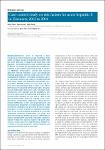Case-control study on risk factors for acute hepatitis E in Germany, 2012 to 2014
Faber, Mirko
Askar, Mona
Stark, Klaus
Background
Notified cases of hepatitis E have increased 40-fold in the past 10 years in Germany. Food safety is a major concern as hepatitis E virus (HEV) RNA has been detected in ready-to-eat retail-level food products. The objective of this case–control study was to assess risk factors for autochthonous symptomatic hepatitis E and explore reasons for delays in diagnosis.
Methods: Demographic, clinical and exposure data from notified hepatitis E cases and individually matched population controls were collected in semi-standardised telephone interviews. Conditional logistic regression analysis was used to calculate matched odds ratios (mOR) and population attributable fractions (PAF).
Results: In total, 270 cases and 1,159 controls were included (mean age 53 years, 61% men in both groups). Associated with disease were: consumption of undercooked pork liver, pork, wild boar meat, frankfurters, liver sausage and raw vegetables; contact with waste water (occupational) and various host factors (mORs between 1.9 and 34.1, p value < 0.03). PAF for frankfurters and liver sausage were 17.6%, and 23.6%, respectively. There were statistically significant differences in the clinical presentation and hospitalisation proportion of acute hepatitis E in men and women. Diagnosis was preceded by more invasive procedures in 29.2% of patients, suggesting that hepatitis E was not immediately considered as a common differential diagnosis.
Conclusions: Our study suggests that there are indeed sex-specific differences in disease development and lends important epidemiological evidence to specific ready-to-eat pork products as a major source for autochthonous hepatitis E. A review of existing consumer recommendations and production methods may be indicated.
Dateien zu dieser Publikation

